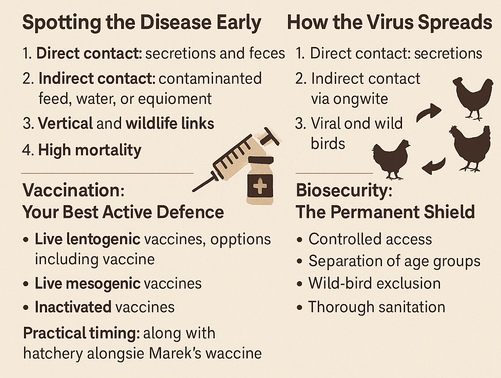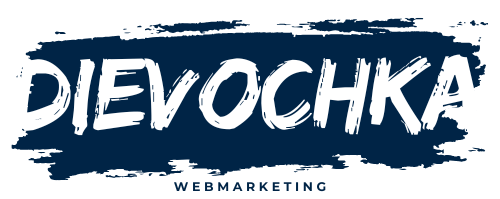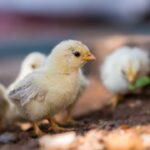Newcastle Disease (ND) is among the most economically damaging infections in poultry production. Caused by avian paramyxovirus-1 (APMV-1), it can wipe out unprotected flocks and disrupt trade within days.
The overview below keeps the spirit of your source text while tightening key facts from veterinary references, organized under clear subtitles and free of tables.
Key Takeaways:
- Newcastle Disease (ND) is highly contagious and can cause near-total flock mortality, especially with velogenic strains.
- Birds shed the virus before symptoms appear; early signs include respiratory, neurological, and digestive issues, plus sudden egg drop.
- NDV spreads via direct contact, contaminated materials, and sometimes wild birds or vertically from parent to chick.
- Vaccination is essential: combine live, inactivated, and vector vaccines at key stages for strong, lasting immunity.
- Biosecurity is critical—daily disinfection, access control, and flock separation help prevent outbreaks.
- ND is manageable with vigilance, smart vaccination, and strict hygiene.
Understanding the Threat
- Virus basics : The Newcastle Disease virus (NDV) belongs to the genus Avulavirus and occurs in three pathotypes for chickens: lentogenic (mild), mesogenic (intermediate) and velogenic (highly virulent, subdivided into viscerotropic and neurotropic forms). Velogenic strains can push flock mortality close to 100 % if birds are unvaccinated.
- Incubation window : Signs typically appear 2 – 15 days after exposure, sooner with more virulent strains.
- Environmental stamina : NDV survives for months in frozen carcasses or eggs but is destroyed by 30 minutes at 60 °C, direct sunlight, or standard disinfectants.
Because birds begin shedding virus before obvious illness and the pathogen persists on equipment and in litter, vaccination must always pair with tight hygiene. If you would like to learn more, please visit the Poultry CEVA website.
Spotting the Disease Early
ND is a “great imitator,” so rapid recognition saves time and birds. Watch for:
- Respiratory signs: coughing, sneezing, nasal discharge.
- Neurological signs: twisted neck (torticollis), paralysis, loss of coordination.
- Digestive signs: greenish or watery diarrhoea, leading to dehydration.
- Production drops: sudden fall in egg numbers or thin-shelled eggs.
- High, unexplained mortality, especially in young or unvaccinated flocks.
Different pathotypes can overlap in presentation; confirm suspicions quickly with PCR or virus isolation.

How the Virus Spreads ?
- Direct contact : Respiratory secretions, faeces and eggs of infected birds are potent sources of virus.
- Indirect contact : Contaminated feed, water, equipment or clothing can carry NDV between sheds.
- Vertical and wildlife links : Although rare, parent birds may pass virus to chicks; wild waterfowl or pigeons can introduce field strains, especially to free-range flocks.
A single laps, an unwashed feed bucket or a visitor’s dirty boots—can ignite an outbreak.
Vaccination: Your Best Active Defence
Vaccination will not always block infection completely, but it prevents severe disease and drastically reduces virus shedding.
Main options
- Live lentogenic vaccines (e.g., Hitchner B1, La Sota) : Provide fast mucosal immunity and can be mass-applied by spray or drinking water; require regular boosters.
- Live mesogenic vaccines (e.g., Roakin, Komarov) : Offer longer-lasting protection but are safe only after birds have been primed; suited to regions where ND is endemic.
- Inactivated oil-emulsion vaccines : Extremely safe and induce strong systemic antibodies but need individual injections, making them labour-intensive for large flocks.
- Recombinant vector vaccines (HVT-NDV) : Administered at the hatchery alongside Marek’s vaccine; low reaction risk and a solid foundation for later live boosters.
Practical timing
- Hatch day: Coarse spray with a live lentogenic vaccine or subcutaneous HVT-NDV vector to start immunity before chicks meet field virus.
- 7–10 days: Second live dose once maternal antibodies begin to wane.
- 3–4 weeks: Another live booster to strengthen mucosal barriers.
- Pre-lay (layers and breeders): Inactivated injection for long-term systemic antibodies; in high-risk zones add a mesogenic “harden-off” shot just before peak production.
Fine-tune intervals by checking antibody titres and watching local outbreak pressure.
Biosecurity: The Permanent Shield
Even the best vaccine schedule collapses without strict hygiene. Key measures include:
- Controlled access : Limit visitors; change boots and coveralls; disinfect hands and tools at every entry.
- Separation of age groups : All-in/all-out flock management breaks the infection cycle.
- Wild-bird exclusion : Use netting, enclosed feeders and secure water lines to deter pigeons and waterfowl.
- Thorough sanitation : Clean and disinfect houses, equipment and carcass-disposal areas; NDV succumbs quickly to heat and approved disinfectants.
- Quarantine and culling : At first confirmation, isolate the premises, depopulate affected pens, and deep-clean before restocking.
Biosecurity is not a checklist; it is a daily mindset shared by every farm worker.

Newcastle Disease remains a global threat, but informed poultry keepers can stay ahead of it. Recognise the signs early, understand how the virus travels, vaccinate strategically, and lock down biosecurity. By blending these measures, ND shifts from a looming catastrophe to a manageable risk, protecting both bird welfare and your bottom line.



